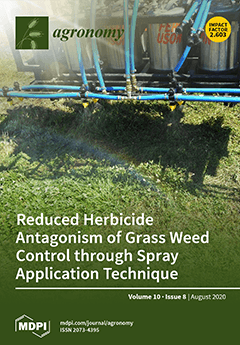Surface (0–10 cm) and subsoil (soil layers below 10 cm) acidity and resulting aluminum (Al) toxicity reduce crop grain yields. In South Western Australia (SWA), these constraints affect 14.2 million hectares or 53% of the agricultural area. Both lime (L, CaCO
3) and gypsum (G, CaSO
4) application can decrease the toxic effect of Al, leading to an increase in crop grain yields. Within the region, it is unclear if G alone or the combined use of L and G has a role in alleviating soil acidity in SWA, due to low sulfate S (SO
4–S) sorption properties of the soil. We present results from three experiments located in the eastern wheatbelt of SWA, which examined the short-term (ST, 2 growing seasons), medium-term (MT, 3 growing seasons), and long-term (LT, 7 growing seasons over 10 years) effects of L and G on grain yield and plant nutrient concentrations. Despite the rapid leaching of SO
4–S and no self-liming impact, it was profitable to apply G, due to the significant ST grain yield responses. The grain yield response to G developed even following relatively dry years, but declined over time due to SO
4–S leaching. At the LT experimental site had received no previous L application, whereas, at the ST and MT sites, L had been applied by the grower over the previous 5–10 years. For the LT site, the most profitable treatment for wheat (
Triticum aestivum L.) grain yield, was the combined application of 4 t L ha
−1 with 2 t G ha
−1. At this site, the 0–10 cm soil pH
CaCl2 was 4.6, and Al
CaCl2 was greater than 2.5 mg kg
−1 in the 10–30 cm soil layer. In contrast, at the ST and MT sites, the pH
CaCl2 of 0–10 cm soil layer was ≥5.5; it was only profitable to apply G to the MT site where the soil compaction constraint had been removed by deep ripping. The use of L increases soil pH
CaCl2, resulting in the improved availability of anions, phosphorus (P) in the LT and molybdenum (Mo) at all sampling times, but reduced availability of cations zinc (Zn) in the LT and manganese (Mn) at all sampling. The application of G reduced Mo concentrations, due to the high SO
4–S content of the soil.
Full article





